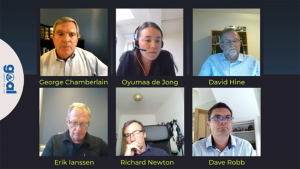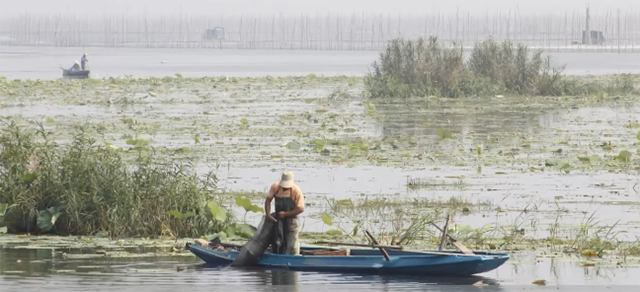Virtual conference session focuses on green financing, carbon farming, electric fishing vessels and more

The role of seafood production systems and how they perform in a changing climate was dissected in a wide-ranging series of presentations at the Global Seafood Alliance’s virtual GOAL conference session on Thursday.
GSA President and session moderator George Chamberlain set the tone for the conversation, which took place after a series of alarming stories in recent weeks, including a report from the International Panel on Climate Change (IPCC), which stated that anthropogenic activity is warming the planet at a faster rate than previously believed and that targets set by the Paris Climate Agreement will be exceeded.
“It’s sobering news,” said Chamberlain, “indicating that we are already 1.1 degrees [Centigrade] above pre-industrial levels. The goal was not to exceed 1.5 degrees by the year 2050. If we continue at our current pace, we will be at 3 degrees.” Chamberlain also noted that the U.S. National Oceanic and Atmospheric Administration just reported that July was the hottest month since recordkeeping began 142 years ago.
With a growing global population and with prosperity on the rise, demand for animal protein is increasing, yet food production contributes roughly one-quarter of anthropogenic greenhouse gas (GHG) emissions, Chamberlain said food systems are in a “dilemma.”
“[Food systems] must do their part to cut [GHG] emissions. Current systems cannot be scale the way they are to meet this demand. We must transform,” he said. “Seafood is a tremendous food source, nutrient-dense with unsaturated fats and micronutrients important during pregnancy and early child development. And seafood is low in carbon emissions already and involves no land-use changes. That’s one of the biggest sources of greenhouse gases. The climate crisis is the defining issue of our time. It’s real, it’s looming and changes are needed.”
https://www.aquaculturealliance.org/advocate/aquaculture-feed-companies-embark-on-a-carbon-cutting-journey/
How will this transformation be financed?
Oyumaa de Jong, sustainable finance specialist at Rabobank, said that “sustainable” financing has been dominating the market since 2012. Sustainability bonds are a “crossover” between green bonds – in which the proceeds fund environmental projects or assets – and social bonds, in which the proceeds fund social projects or assets. This type of financing provides a measurement of how well a borrower performs, she explained.
“For companies to borrow money in this way they need a framework and do impact reporting, and then steer capital to environmental or social projects or assets,” she explained. “It’s a big limitation, as not every issuer who wants to engage has enough projects to finance.”
While sustainability bonds decrease the hurdles for issuers, she added, they help corporations align with Sustainable Development Goals (SDG) targets and tie the way they are financed to the way they perform with regard to responsibility commitments.
“We see companies committing to reducing their carbon footprints. Other relevant metrics often used are waste reduction, water reduction increasing sustainable sourcing, farmer training, safety and diversity issues, etc.,” she said.
The way current sustainability bonds work, companies are awarded a discount on the margin they pay on the loan if they reach their targets. If they miss their targets, the margin increases, so there is an obvious financial incentive. De Jong added that transparency and disclosure requirements are stringent.
“It’s gone from niche beginnings to a full-fledged market,” she said. “I really believe we’re headed to a new normal. Investors are under more pressure to put their money in greener baskets.”
The greatest challenge going forward, she concluded, will be greenwashing, or making sure that companies are making accurate claims: “If properly structured, [sustainability bonds] are a great tool to mitigate climate change.”
Teslas on the water?
Erik Ianssen said that his fifth-generation family company in Norway, Selfa Arctic AS, has been building boats for decades. And while it has manufactured 800 seafood vessels since 1979, and has become a market leader in Norway, he’s most proud of one vessel in particular: The MK Karoline.
The first electric fishing vessel in the world, he claimed, was launched in 2015 and – if more operators commit to the parallel hybrid engine technology that Selfa has pioneered – can lead the way as Norway aims to reduce it’s dependence on petroleum. Norway consumed 8 billion liters of diesel in 2020, with the maritime sector accounting for a full 25 percent, he said.
“We cannot do anything about soya [in aquafeeds] or airplanes [for shipping], but consumption of petroleum we can really do something with,” he said.
The maritime sector in Norway, he added, is the only one with an increasing demand for petroleum, as usage increased 7.3 percent last year.
The outsized impact of feed

Dr. Richard Newton, a researcher at the University of Stirling (UK), said that it is imperative that the growing global aquaculture industry be more efficient with the use of aquafeeds, which he said contribute 95 percent of the industry’s carbon, water and land footprints.
“Environmental impact is high in consumer consciousness. Retail and consumer organizations want more transparency regarding responsible sourcing. Certification bodies want to develop more harmonized sustainability metrics,” he said. “But with the ever-increasing pool of [aquafeed] ingredients, [procurement] policies and sustainability credentials are not always clear.”
Newton said that all livestock – terrestrial or aquatic – is virtually dependent on soy and other plant ingredients and the industry doesn’t always have good control of how such ingredients are produced. The soy industry, he added, creates more protein for livestock production than any other source, yet is often beset with land-use issues and deforestation, which has a large impact on emissions and the ability to sequester carbon. To really get a grip on the overall impact of seafood production, one must understand that environmental impacts do not occur solely on the production level, he explained.
“Feed ingredients, processing, farm production, processing of the animal, distribution, consumption, waste disposal – all require land water raw materials and energy and can lead to harmful emissions. The footprint of marine ingredients depends on fuel intensity, boat and gear maintenance and rendering yields. And with marine ingredients, not all fishmeal is the same, not all fish oil is the same. A lot depends on species, location and the way it’s caught.”
For instance, purse-seined pelagic species have a lower fuel intensity than midwater or demersal trawls, and the use of byproduct resources has a low footprint as it is redirected from waste streams.
One of the audience poll questions asked attendees about the responsibility for addressing seafood’s environmental impacts: Governments, non-governmental organizations (NGOs), the seafood supply chain itself or consumers.
“We’ve all got our part to play,” said Dave Robb, lead of animal feed giant Cargill’s SeaFurther Sustainability Program. “We see consumers demanding more information, governments increasingly addressing this through incentives and NGOs holding us to account.”
“There’s no simple answer; it’s a mixture,” said Newton. “Ultimately, the collective action of consumers will make a large difference but they need the information in front of them to make good decisions.”
David Hine, owner of Land and Water Management PL and an advisor on sustainability in agriculture, presented on “carbon farming,” or the idea that farmers can sequester carbon in row crops to generate a negative carbon footprint and earn carbon credits that can be sold or traded. To view his presentation and all the others, please visit our conference platform.
Follow the Advocate on Twitter @GAA_Advocate
Now that you've finished reading the article ...
… we hope you’ll consider supporting our mission to document the evolution of the global aquaculture industry and share our vast network of contributors’ expansive knowledge every week.
By becoming a Global Seafood Alliance member, you’re ensuring that all of the pre-competitive work we do through member benefits, resources and events can continue. Individual membership costs just $50 a year. GSA individual and corporate members receive complimentary access to a series of GOAL virtual events beginning in April. Join now.
Not a GSA member? Join us.
Author
-

James Wright
Editorial Manager
Global Seafood Alliance
Portsmouth, NH, USA

